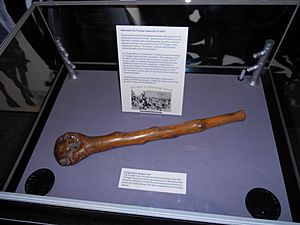Bloody Sunday (1887) facts for kids
Quick facts for kids Bloody Sunday |
|||
|---|---|---|---|
| Part of the Irish Home Rule movement | |||

Engraving from The Graphic (published 19 November 1887) depicting a policeman being clubbed by a demonstrator as he wrests a banner from "a Socialist woman leader, one Mrs. Taylor", while other people are covering their heads to protect themselves from raised police batons.
|
|||
| Date | 13 November 1887 | ||
| Location | |||
| Caused by |
|
||
| Goals |
|
||
| Methods | Political demonstration | ||
| Parties to the civil conflict | |||
|
|||
| Lead figures | |||
|
|||
| Number | |||
|
|||
| Casualties | |||
| Injuries | 75 badly injured (all sides) | ||
| Arrested | 400 | ||
Bloody Sunday was a big event that happened in London, England on November 13, 1887. Many people marched to protest about not having jobs and unfair laws in Ireland. They also wanted a politician named William O'Brien to be set free. During the protest, the marchers clashed with the police. This demonstration was organized by groups like the Social Democratic Federation and the Irish National League. There were violent fights between the police and the protesters. Many people were hurt, and about 400 people were arrested.
Contents
Why Did People Protest?
Unemployment and Hard Times
In the late 1800s, Britain was going through a tough economic period. This time was called the Long Depression. It meant that many people lost their jobs, especially in the countryside. Because of this, many workers moved to cities like London. This made it even harder to find work and earn enough money.
Protesting Irish Laws
Another big reason for the protest was the situation in Ireland. The British government had passed strict laws called the Coercion Acts. These laws limited people's rights in Ireland. Many people in Britain, especially those with Irish backgrounds, felt these laws were unfair. They wanted Home Rule for Ireland, which meant Ireland would have more control over its own affairs.
Trafalgar Square: A Meeting Point
Protesters often gathered in Trafalgar Square in London. This square was seen as a place where the working-class areas met the wealthier parts of the city. It became a symbol of the struggle between different social classes. Groups like the Social Democratic Federation and the Fabian Society joined the protests. They wanted to help the unemployed and support the cause of Irish rights.
The Day of the Demonstration
On November 13, 1887, thousands of people gathered to march. About 10,000 protesters marched towards Trafalgar Square from different parts of London. Famous leaders like John Burns, William Morris, and Annie Besant led some of these groups. Many other people, around 30,000, came to watch.
The police and army were ready for the protest. About 2,000 police officers and 400 soldiers were sent to stop the marchers. When the protesters reached Trafalgar Square, clashes broke out. Police used their batons, and some protesters fought back with various objects.
Many people were injured during the fighting. Some protesters were hurt by police batons or by police horses. Two police officers were stabbed. About 400 people were arrested that day.
What Happened Next?
A week later, on November 20, another protest took place. More people were injured. One young man named Alfred Linnell was hurt by a police horse and sadly died a few weeks later. His funeral became another protest event. People gathered to show their support for the cause and to remember those who were hurt or killed.
The events of Bloody Sunday showed the deep social and economic problems in Britain at the time. It also highlighted the strong feelings about Irish rights.
See also
- Belgian strikes of 1886


